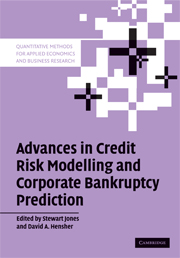Book contents
- Frontmatter
- Contents
- List of figures
- List of tables
- List of contributors
- Introduction
- 1 A statistical model for credit scoring
- 2 Mixed logit and error component models of corporate insolvency and bankruptcy risk
- 3 An evaluation of open- and closed-form distress prediction models: The nested logit and latent class models
- 4 Survival analysis and omitted dividends
- 5 Non-parametric methods for credit risk analysis: Neural networks and recursive partitioning techniques
- 6 Bankruptcy prediction and structural credit risk models
- 7 Default recovery rates and LGD in credit risk modelling and practice: An updated review of the literature and empirical evidence
- 8 Credit derivatives: Current practices and controversies
- 9 Local government distress in Australia: A latent class regression analysis
- 10 A belief-function perspective to credit risk assessments
- Index
- References
9 - Local government distress in Australia: A latent class regression analysis
Published online by Cambridge University Press: 11 June 2010
- Frontmatter
- Contents
- List of figures
- List of tables
- List of contributors
- Introduction
- 1 A statistical model for credit scoring
- 2 Mixed logit and error component models of corporate insolvency and bankruptcy risk
- 3 An evaluation of open- and closed-form distress prediction models: The nested logit and latent class models
- 4 Survival analysis and omitted dividends
- 5 Non-parametric methods for credit risk analysis: Neural networks and recursive partitioning techniques
- 6 Bankruptcy prediction and structural credit risk models
- 7 Default recovery rates and LGD in credit risk modelling and practice: An updated review of the literature and empirical evidence
- 8 Credit derivatives: Current practices and controversies
- 9 Local government distress in Australia: A latent class regression analysis
- 10 A belief-function perspective to credit risk assessments
- Index
- References
Summary
Introduction
The main focus of previous chapters in this volume has been on corporations in the private sector, and in particular, on those corporations whose securities are publicly traded (possibly because financial and market data about these firms were readily available). In this context, ‘distress’ has been variously interpreted as being evidenced by voluntary or creditor-induced administration (bankruptcy), default on a loan repayment, failure to pay a preference dividend (or even a reduction in the amount of ordinary dividend payments), share issues specifically to meet shortfalls in working capital, financial reorganization where debt is forgiven or converted to equity, and a failure to pay listing fees (see e.g. Foster 1986, Lau 1987, Ward 1994, Bahnson and Bartley 1992, Jones and Hensher 2004).
This chapter is concerned with distress in the public sector, and focuses on local government in the state of New South Wales. We interpret distress in terms of an inability of local governments to provide services at pre-existing levels. In order to provide services to the community, local governments are expected to invest in infrastructure and to maintain legacy infrastructure. Accordingly, we use the estimates developed by local governments of the cost of restoring infrastructure to a satisfactory condition as a measure of degrees of ‘distress’. As such, the study uses a quantitative measure of distress, as opposed to the more limited (and less relevant) binary classification that characterizes private sector distress research.
- Type
- Chapter
- Information
- Publisher: Cambridge University PressPrint publication year: 2008



